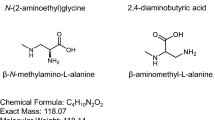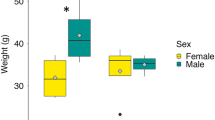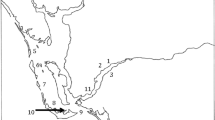Abstract
Cyanobacterial blooms have affected Lake Winnipeg since the mid-1990s due to an increased phosphorus loading into the lake, which has been exacerbated by stressors such as climate change and eutrophication. Aquatic ecosystems involving cyanobacteria have been found to contain N-β-methylamino-L-alanine (BMAA) and 2,4-diaminobutyric acid (DAB), non-protein amino acids that are associated with neurodegenerative disease, as well as two of the naturally occurring isomers, N-2(amino)ethylglycine (AEG) and β-amino-N-methylalanine (BAMA). We hypothesized that the cyanobacterial bloom in Lake Winnipeg produces BMAA and/or its naturally occurring isomers. Samples of cyanobacteria were collected by the Lake Winnipeg Research Consortium from standard sampling stations and blooms in July and September of 2016 and were analyzed for BMAA, DAB, AEG, and BAMA using previously published validated analytical methods. BMAA and BAMA were found in the highest concentration in the center of the north basin, the deepest and lowest-nitrogen zone of the lake, at an average concentration of 4 μg/g (collected in July and September 2016) and 1.5 mg/g (collected in July 2016), respectively. AEG and DAB were found in the highest concentration in cyanobacterial blooms from the nearshore region of the north basin, the slightly shallower and more nitrogen-rich zone of the lake, at 2.1 mg/g (collected in July 2016) and 0.2 mg/g (collected in July and September 2016), respectively. These findings indicate that the production of non-protein amino acids varies with the depth and nutrient contents of the bloom. It is important to note that we did not measure food or water samples directly and further study of the Lake Winnipeg food web is required to determine whether BMAA bioaccumulation represents an increased risk factor for neurodegenerative disease in the region.








Similar content being viewed by others
References
Arnold A, Edgren DC, Palladino VS (1953) Amyotrophic lateral sclerosis; fifty cases observed on Guam. J Nerv Ment Dis 117:135–139
Baker TC, Tymm FJM, Murch SJ (2017) Assessing environmental exposure to β-N-methylamino-L-alanine (BMAA) in complex sample matrices: a comparison of the three most popular LC-MS/MS methods. Neurotox Res. https://doi.org/10.1007/s12640-017-9764-3
Banack SA, Murch SJ (2009) Multiple items in the Chamorro diet link BMAA with ALS/PDC. Amyotrophic Lateral Sclerosis Supplement 2:34–40
Banack SA, Downing TG, Spacil Z, Purdie EL, Metcalf JS, Downing S, Esterhuizen M, Codd GA, Cox PA (2010) Distinguishing the cyanobacterial neurotoxin beta-N-methylamino-L-alanine (BMAA) from its structural isomer 2,4-diaminobutyric acid (2,4-DAB). Toxicon 56:868–879
Brand LE, Pablo J, Compton A, Hammerschlag N, Mash DC (2010) Cyanobacteria blooms and the occurrence of the neurotoxin, beta-N-methylamino-L-alanine (BMAA), in South Florida aquatic food webs. Harmful Algae 9:620–635
Brunskill GJ, Elliott SEM, Campbell P (1980) Morphometry, hydrology, and watershed data pertinent to the limnology of Lake Winnipeg. Can Manuscr Rep Fish Aquat Sci 1556:1–32
Bunting L, Leavitt PR, Simpson GL, Wissel B, Laird KR, Cumming BF, St. Amand A, Engstrom DR (2016) Increased variability and sudden ecosystem state change in Lake Winnipeg, Canada, caused by 20th century agriculture. Limnol Oceanogr 61:2090–2107
Carmichael WW, Boyer GL (2016) Health impacts from harmful algae blooms: implications for the North American Great Lakes. Harmful Algae 54:194–212
Cirés S, Ballot A (2016) A review of the phylogeny, ecology and toxin production of bloom-forming Aphanizomenon spp. and related species within the Nostocales (cyanobacteria). Harmful Algae 54:21–43
Cox PA, Sacks OW (2002) Cycad neurotoxins, consumption of flying foxes, and ALS-PDC disease in Guam. Neurology 58:956–959
Cox PA, Banack SA, Murch SJ, Rasmussen U, Tien G, Bidigare RR, Metcalf JS, Morrison LF, Codd GA, Bergman B (2005) Diverse taxa of cyanobacteria produce beta-N-methylamino-L-alanine, a neurotoxic amino acid. Proc Natl Acad Sci U S A 102:5074–5078
Cox PA, Davis DA, Mash DC, Metcalf JS, Banack SA (2016) Dietary exposure to an environmental toxin triggers neurofibrillary tangles and amyloid deposits in the brain. Proc R Soc B 283:20152397
D’Mello F, Braidy N, Marcal H, Guillemin G, Rossi F, Chinian M, Laurent D, Teo C, Neilan BA (2017) Cytotoxic effects of environmental toxins on human glial cells. Neurotox Res 31:245–258
Downing TG, Phelan RR, Downing S (2015) A potential physiological role for cyanotoxins in cyanobacteria of arid environments. J Arid Environ 112:147–151
Downing S, Downing TG (2016) The metabolism of the non-proteinogenic amino acid β-N-methylamino-L-alanine (BMAA) in the cyanobacterium Synechocystis PCC6803. Toxicon 115:41–48
Duncan MW (1991) The role of the cycad neurotoxin BMAA in the ALS-PD of the western Pacific. In: Rowland LP (ed) Advances in neurology. Amyotrophic lateral sclerosis and other motor neuron diseases, vol 56. New York, Raven, pp 301–310
Duncan MW, Kopin IJ, Garruto RM, Lavine L, Markey SP (1988) 2-Amino-3-(methylamino)-propionic acid in cycad-derived foods is an unlikely cause of amyotrophic lateral sclerosis/parkinsonism. Lancet 2:631–632
Duncan MW, Kopin IJ, Crowley JS, Jones SM, Markey SP (1989) Quantification of the putative neurotoxin 2-amino-3-(methylamino) propanoic acid (BMAA) in cycadales: analysis ofthe seeds of some members of the family Cycadaceae. J Anal Toxicol 13:169–l75
Dunlop RA, Cox PA, Banack SA, Rodgers KJ (2013) The non-protein amino acid BMAA is misincorporated into human proteins in place of L-serine causing protein misfolding and aggregation. PLoS One 8:e75376
Environment and Climate Change Canada (2016) Canadian environmental sustainability indicators: nutrients in Lake Winnipeg http://www.ec.gc.ca/indicateurs-indicators/default.asp?lang=en&n=55379785-1
Environment Canada (2012) Final project reports: Lake Winnipeg Basin Initiative 2008/09–2011/12. https://mspace.lib.umanitoba.ca/xmlui/bitstream/handle/1993/23444/FinalProjectReports_LWpgB_In2008_2012.pdf?sequence=1&isAllowed=y
Glover WB, Liberto CM, McNeil WS, Banack SA, Shipley PR, Murch SJ (2012) Reactivity of β-methylamino-L-alanine in complex sample matrices complicates detection and quantification by mass spectrometry. Anal Chem 84:7946–7953
Glover WB, Mash DC, Murch SJ (2014) The natural non-protein amino acid N-beta-methylamino-L-alanine (BMAA) is incorporated into protein during synthesis. Amino Acids 46:2553–2559
Glover WB, Baker TC, Murch SJ, Brown PN (2015) Determination of beta-N-methylamino-L-alanine, N-(2-aminoethyl)glycine, and 2,4-diaminobutyric acid in food products containing cyanobacteria by ultra-performance liquid chromatography and tandem mass spectrometry: single-laboratory validation. J AOAC Int 98:1559–1565
Jiang L, Kiselova N, Rosen J, Ilag LL (2014) Quantification of neurotoxin BMAA (β-N-methylamino-L-alanine) in seafood from Swedish markets. Sci Rep 4(6931):1–7
Jiang L, Aigret B, De Borggraeve WM, Spacil Z, Ilag LL (2012) Selective LC-MS/MS method for the identification of BMAA from its isomers in biological samples. Anal Bioanal Chem 403:1719–1730
Jonasson S, Eriksson J, Berntzon L, Spácil Z, Ilag LL, Ronnevi L-O, Rasmussen U, Bergman B (2010) Transfer of a cyanobacterial neurotoxin within a temperate aquatic ecosystem suggests pathways for human exposure. Proc Natl Acad Sci U S A 107:9252–9257
McCullough GK, Page SJ, Hesslein RH, Stainton MP, Kling HJ, Salki AG, Barber DG (2012) Hydrological forcing of a recent trophic surge in Lake Winnipeg. J Great Lakes Res 38:95–105
Mondo K, Glover WB, Murch SJ, Liu G, Cai Y, Davis DA, Mash DC (2014) Environmental neurotoxins β-N-methylamino-L-alanine (BMAA) and mercury in shark cartilage dietary supplements. Food Chem Toxicol 70:26–32
Monteiro M, Costa M, Moreira C, Vasconcelos VM, Baptista MS (2017) Screening of BMAA-producing cyanobacteria in cultured isolates and in in situ blooms. J Appl Phycol 29:879–888
Murch SJ, Cox PA, Banack SA (2004a) A mechanism for slow release of biomagnified cyanobacterial neurotoxins and neurodegenerative disease in Guam. Proc Natl Acad Sci U S A 101:12228–12231
Murch SJ, Cox PA, Banack SA, Steele JC, Sacks OW (2004b) Occurrence of beta-methylamino-l-alanine (BMAA) in ALS/PDC patients from Guam. Acta Neurol Scand 110:267–269
Pip E, Munford K, Bowman L (2016) Seasonal nearshore occurrence of the neurotoxin β-N-methylamino-L-alanine (BMAA) in Lake Winnipeg, Canada. Environ Pollut 5:110–118
Rauk A (2017) Does substitution of BMAA for serine alter conformational dynamics of the amyloid beta peptide of Alzheimer’s disease: molecular dynamics simulations 100th Canadian Chemistry Conference Abstract #00260 http://abstracts.csc2017.ca/00000945.htm
Reed D, Labarthe D, Chen KM, Stallones R (1987) A cohort study of amyotrophic lateral sclerosis and parkinsonism-dementia on Guam and Rota. Am J Epidemiol 125:92–100
Réveillon D, Abadie E, Séchet V, Masseret E, Hess P, Amzil Z (2015) β-N-methylamino-L-alanine (BMAA) and isomers: distribution in different food web compartments of Thau Lagoon, French Mediterranean Sea. Mar Environ Res 110:8–18
Schwartz R, Forchhammer K (2005) Acclimation of unicellular cyanobacteria to macronutrient deficiency: emergence of a complex network of cellular responses. Microbiology 151:2503–2514
Scott KJ (2017) Lake Winnipeg Research Consortium Inc. 2016/2017 annual report. http://www.lakewinnipegresearch.org/pdf%20files/LWRC%202016_17%20Programs%20Report%20FINAL.pdf
Scott KJ, McCullough G, Stainton M, Ayles B, Hann B (2011) Lake Winnipeg-state of science: what is the scientific basis for understanding and protecting Lake Winnipeg? http://www.lakewinnipegresearch.org/pdf%20files/LWRC%202011%20Sci%20WS%20Report_FINAL_web.pdf
Shen H, Kim K, Oh Y, Yoon KS, Baik HH, Kim SS, Ha J, Kang I, Choe W (2016) Neurotoxin β-N-methylamino-L-alanine induces endoplasmic reticulum stress-mediated neuronal apoptosis. Mol Med Rep 14:4873–4880
Spencer PS, Nunn PB, Hugon J, Ludolph AC, Ross SM, Roy DN, Robertson RC (1987) Guam amyotrophic lateral sclerosis-parkinsonism-dementia linked to a plant excitant neurotoxin. Science 237:517–522
Vega A, Bell E (1967) α-Amino-β-methylaminopropionic acid, a new amino acid from seeds of Cycas circinalis. Phytochemistry (Oxford) 6:759–762
Vega A, Bell E, Nunn P (1968) The preparation of l- and d-α-amino-β-methylaminopropionic acids and the identification of the compound isolated from Cycas circinalis as the l-isomer. Phytochemistry (Oxford) 7:1885–1887
Wassenaar LI, Rao YR (2012) Lake Winnipeg: the forgotten Great Lake. J Great Lakes Res 38:1–5
Whiting MG (1963) Toxicity of cycads. Econ Bot 17:270–302
Acknowledgements
We would like to acknowledge Karen Scott, the Lake Winnipeg Research Consortium, and the crew of the Namao as well as funding from the Natural Sciences and Engineering Research Council of Canada, the Canadian Foundation for Innovation, and the Canada Research Chairs program.
Author information
Authors and Affiliations
Corresponding author
Ethics declarations
Conflict of Interest
The authors declare that they have no conflict of interest.
Electronic supplementary material
ESM 1
(DOCX 1700 kb).
Rights and permissions
About this article
Cite this article
Bishop, S.L., Kerkovius, J.K., Menard, F. et al. N-β-Methylamino-L-Alanine and Its Naturally Occurring Isomers in Cyanobacterial Blooms in Lake Winnipeg. Neurotox Res 33, 133–142 (2018). https://doi.org/10.1007/s12640-017-9820-z
Received:
Revised:
Accepted:
Published:
Issue Date:
DOI: https://doi.org/10.1007/s12640-017-9820-z




